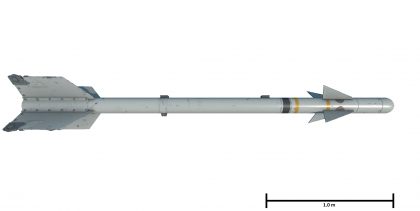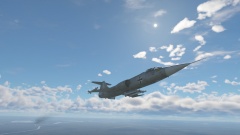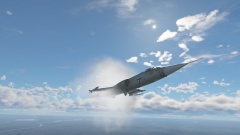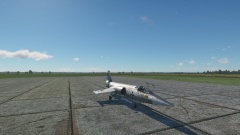Difference between revisions of "AIM-9B FGW.2 Sidewinder"
Colok76286 (talk | contribs) (Edits) |
(→Comparison with analogues: add comparison table) |
||
| (11 intermediate revisions by 6 users not shown) | |||
| Line 1: | Line 1: | ||
| + | {{About | ||
| + | | about = German air-to-air missile '''{{PAGENAME}}''' | ||
| + | | usage = other versions | ||
| + | | link = AIM-9 Sidewinder (Family) | ||
| + | }} | ||
== Description == | == Description == | ||
| − | <!--''Write an introduction to the article in 2-3 small paragraphs. Briefly tell us about the history of the development and combat using the weaponry and also about its features. Compile a list of air, ground, or naval vehicles that feature this weapon system in the game.''--> | + | <!-- ''Write an introduction to the article in 2-3 small paragraphs. Briefly tell us about the history of the development and combat using the weaponry and also about its features. Compile a list of air, ground, or naval vehicles that feature this weapon system in the game.'' --> |
[[File:WeaponImage AIM-9B Sidewinder.png|thumb|left|420px|The AIM-9B Sidewinder missile (scale is approximate)]] | [[File:WeaponImage AIM-9B Sidewinder.png|thumb|left|420px|The AIM-9B Sidewinder missile (scale is approximate)]] | ||
{{Break}} | {{Break}} | ||
| − | The | + | The '''{{PAGENAME}}''' is a German [[Air-to-air_missiles#Infrared_homing_.28heat-seeking.29_missiles|infrared homing air-to-air missile]], it was introduced in [[Update "Starfighters"]]. |
=== Vehicles equipped with this weapon === | === Vehicles equipped with this weapon === | ||
| Line 13: | Line 18: | ||
== General info == | == General info == | ||
| − | <!--''Tell us about the tactical and technical characteristics of the missile.''--> | + | <!-- ''Tell us about the tactical and technical characteristics of the missile.'' --> |
| − | + | The AIM-9B FGW.2 is known also as the AIM-9F, an upgrade to the AIM-9B. The differences between the E and F variants are a different design philosophy including a slightly different sensor window, solid state electronics instead of vacuum tubes, and a new cooling system. | |
| − | + | With similar performance to the AIM-9B, the FGW.2 should be treated the same way. The missile's performance is generally subpar in comparison to other missiles found in the same BR range, thanks to the FGW.2 base having stats of a missile designed in 1954-6. With only 10 G of overload, it performs terribly in high-G dogfights. The missile will be ready to fire in 1 second, while the target search time amounts to 20 seconds. | |
| + | |||
| + | {| class="wikitable" style="text-align:center" | ||
| + | ! colspan="2" | Missile characteristics | ||
| + | |- | ||
| + | | '''Mass''' || 72 kg | ||
| + | |- | ||
| + | | '''Guidance''' || IR | ||
| + | |- | ||
| + | | '''Aspect''' || Rear-aspect | ||
| + | |- | ||
| + | | '''Lock range (rear-aspect)''' || 5.5 km | ||
| + | |- | ||
| + | | '''Launch range''' || 10 km | ||
| + | |- | ||
| + | | '''Maximum speed''' || 1.7 M | ||
| + | |- | ||
| + | | '''Maximum overload''' || 10 G | ||
| + | |- | ||
| + | | '''Missile guidance time''' || 20 secs | ||
| + | |- | ||
| + | | '''Explosive mass''' || 7.62 kg TNTeq | ||
| + | |- | ||
| + | |} | ||
=== Effective damage === | === Effective damage === | ||
| − | <!--''Describe the type of damage produced by this type of missile (high explosive, splash damage, etc)''--> | + | <!-- ''Describe the type of damage produced by this type of missile (high explosive, splash damage, etc)'' --> |
| − | + | While being relatively bad compared to other missiles, the FGW.2 does not disappoint in the damage department. Like every other AAM, if this missile connects, it will knock out or at least deal critical damage to any aircraft. Obviously, it can't be used against ground targets, unless you count parked and active aircraft. | |
=== Comparison with analogues === | === Comparison with analogues === | ||
<!--''Give a comparative description of missiles that have firepower equal to this weapon.''--> | <!--''Give a comparative description of missiles that have firepower equal to this weapon.''--> | ||
Its performance is identical to the [[AIM-9B Sidewinder|AIM-9B]] and [[R-3S|R-3]] missiles, but is massively outperformed by mid-tier missiles like the [[AIM-9D Sidewinder|AIM-9D]], [[AIM-9E Sidewinder|E]], [[R-60]], and [[Matra R550 Magic 1|R550]]. Its lack of a movable seeker-head, higher G-pulling, range, and sensitivity make it subpar if not for having four missiles on a platform that is capable of traveling at Mach 2. | Its performance is identical to the [[AIM-9B Sidewinder|AIM-9B]] and [[R-3S|R-3]] missiles, but is massively outperformed by mid-tier missiles like the [[AIM-9D Sidewinder|AIM-9D]], [[AIM-9E Sidewinder|E]], [[R-60]], and [[Matra R550 Magic 1|R550]]. Its lack of a movable seeker-head, higher G-pulling, range, and sensitivity make it subpar if not for having four missiles on a platform that is capable of traveling at Mach 2. | ||
| + | |||
| + | {{AIM-9 Comparison Table}} | ||
== Usage in battles == | == Usage in battles == | ||
| − | <!--''Describe situations when you would utilise this missile in-game (vehicle, pillbox, base, etc)''--> | + | <!-- ''Describe situations when you would utilise this missile in-game (vehicle, pillbox, base, etc)'' --> |
This missile's best usage comes in three situations, low energy, roll-rate spamming and compressed enemies: | This missile's best usage comes in three situations, low energy, roll-rate spamming and compressed enemies: | ||
| Line 36: | Line 66: | ||
* Enemies that have high compression speeds will find your missiles hard to dodge as well. The [[Vautour IIA IDF/AF (France)|French Vautour bombers]], high speed [[MiG-15 (Family)|MiG-15]]'s and [[Yak-38]]/[[Yak-38M|38M]], and [[F11F-1]]'s won't be able to outturn the missile's seeker at high speeds, and will be forced to either bleed enough speed to manoeuvre or get hit by the warhead. It has a top speed of around Mach 1.7, so the planes that can outrun this missile with low manoeuvrability are other [[F-104 (Family)|F-104]]'s. | * Enemies that have high compression speeds will find your missiles hard to dodge as well. The [[Vautour IIA IDF/AF (France)|French Vautour bombers]], high speed [[MiG-15 (Family)|MiG-15]]'s and [[Yak-38]]/[[Yak-38M|38M]], and [[F11F-1]]'s won't be able to outturn the missile's seeker at high speeds, and will be forced to either bleed enough speed to manoeuvre or get hit by the warhead. It has a top speed of around Mach 1.7, so the planes that can outrun this missile with low manoeuvrability are other [[F-104 (Family)|F-104]]'s. | ||
| − | Forcing enemies to bleed speed is more of this missile's job, but speed isn't a big deal for the | + | Forcing enemies to bleed speed is more of this missile's job, but speed isn't generally a big deal for the jets it can be equipped on, so it's kind of redundant. |
=== Pros and cons === | === Pros and cons === | ||
| − | <!--''Summarise and briefly evaluate the weaponry in terms of its characteristics and combat effectiveness. Mark pros and cons as a list.''--> | + | <!-- ''Summarise and briefly evaluate the weaponry in terms of its characteristics and combat effectiveness. Mark pros and cons as a list.'' --> |
'''Pros:''' | '''Pros:''' | ||
| Line 56: | Line 86: | ||
== History == | == History == | ||
| − | <!--Examine the history of the creation and combat usage of the weapon in more detail than in the introduction. If the historical reference turns out to be too long, take it to a separate article, taking a link to the article about the weapon and adding a block "/History" (example: <nowiki>https://wiki.warthunder.com/(Weapon-name)/History</nowiki>) and add a link to it here using the <code>main</code> template. Be sure to reference text and sources by using <code><nowiki><ref></ref></nowiki></code>, as well as adding them at the end of the article with <code><nowiki><references /></nowiki></code>.--> | + | <!-- ''Examine the history of the creation and combat usage of the weapon in more detail than in the introduction. If the historical reference turns out to be too long, take it to a separate article, taking a link to the article about the weapon and adding a block "/History" (example: <nowiki>https://wiki.warthunder.com/(Weapon-name)/History</nowiki>) and add a link to it here using the <code>main</code> template. Be sure to reference text and sources by using <code><nowiki><ref></ref></nowiki></code>, as well as adding them at the end of the article with <code><nowiki><references /></nowiki></code>.'' --> |
===Development=== | ===Development=== | ||
The missile's history starts at the Naval Ordnance Test Station (NOTS) at China Lake in 1947.<ref name="Goebel2019">Goebel 2019</ref> Under William B. McLean, the missile conception sprang from mating lead-sulfide proximity fuzes that were sensitive to infrared radiation with a guidance system to home onto the infrared source.<ref name="HollwayFOX2">Hollway</ref> Initially his own private project, McLean eventually received approval by Admiral William S. Parsons for development.<ref name="Goebel2019" />These missiles were first test fired in 1951, with the first air-to-air hit was made on 11 September 1953 on a drone.<ref name="ParschAIM9">Parsch 2008</ref> This experimental missile would be designated as the ''XAAM-N-7''. The missile would also earn the name "Sidewinder" by the development team, named after the desert rattlesnake that senses its prey's heat and moves in a winding motion.<ref name="Goebel2019" /><ref name="HollwayFOX2" /> | The missile's history starts at the Naval Ordnance Test Station (NOTS) at China Lake in 1947.<ref name="Goebel2019">Goebel 2019</ref> Under William B. McLean, the missile conception sprang from mating lead-sulfide proximity fuzes that were sensitive to infrared radiation with a guidance system to home onto the infrared source.<ref name="HollwayFOX2">Hollway</ref> Initially his own private project, McLean eventually received approval by Admiral William S. Parsons for development.<ref name="Goebel2019" />These missiles were first test fired in 1951, with the first air-to-air hit was made on 11 September 1953 on a drone.<ref name="ParschAIM9">Parsch 2008</ref> This experimental missile would be designated as the ''XAAM-N-7''. The missile would also earn the name "Sidewinder" by the development team, named after the desert rattlesnake that senses its prey's heat and moves in a winding motion.<ref name="Goebel2019" /><ref name="HollwayFOX2" /> | ||
| Line 68: | Line 98: | ||
== Media == | == Media == | ||
| − | <!--''Excellent additions to the article would be video guides, screenshots from the game, and photos.''--> | + | <!-- ''Excellent additions to the article would be video guides, screenshots from the game, and photos.'' --> |
;Images | ;Images | ||
| Line 78: | Line 108: | ||
== See also == | == See also == | ||
| − | <!--''Links to the articles on the War Thunder Wiki that you think will be useful for the reader, for example:'' | + | <!-- ''Links to the articles on the War Thunder Wiki that you think will be useful for the reader, for example:'' |
* ''reference to the article about the variant of the weapon;'' | * ''reference to the article about the variant of the weapon;'' | ||
| − | * ''references to approximate analogues by other nations and research trees.''--> | + | * ''references to approximate analogues by other nations and research trees.'' --> |
| + | |||
| + | ;Related development | ||
| − | * [[AIM- | + | * [[AIM-9 Sidewinder (Family)]] |
| − | |||
== External links == | == External links == | ||
| − | <!--Paste links to sources and external resources, such as: | + | <!-- ''Paste links to sources and external resources, such as:'' |
* ''topic on the official game forum;'' | * ''topic on the official game forum;'' | ||
| − | * ''other literature.''--> | + | * ''other literature.'' --> |
* [http://www.military-today.com/missiles/aim_9f_sidewinder.htm <nowiki>[Military Today]</nowiki> AIM-9F Sidewinder] | * [http://www.military-today.com/missiles/aim_9f_sidewinder.htm <nowiki>[Military Today]</nowiki> AIM-9F Sidewinder] | ||
Latest revision as of 15:52, 22 October 2024
| This page is about the German air-to-air missile AIM-9B FGW.2 Sidewinder. For other versions, see AIM-9 Sidewinder (Family). |
Contents
Description
The AIM-9B FGW.2 Sidewinder is a German infrared homing air-to-air missile, it was introduced in Update "Starfighters".
Vehicles equipped with this weapon
General info
The AIM-9B FGW.2 is known also as the AIM-9F, an upgrade to the AIM-9B. The differences between the E and F variants are a different design philosophy including a slightly different sensor window, solid state electronics instead of vacuum tubes, and a new cooling system.
With similar performance to the AIM-9B, the FGW.2 should be treated the same way. The missile's performance is generally subpar in comparison to other missiles found in the same BR range, thanks to the FGW.2 base having stats of a missile designed in 1954-6. With only 10 G of overload, it performs terribly in high-G dogfights. The missile will be ready to fire in 1 second, while the target search time amounts to 20 seconds.
| Missile characteristics | |
|---|---|
| Mass | 72 kg |
| Guidance | IR |
| Aspect | Rear-aspect |
| Lock range (rear-aspect) | 5.5 km |
| Launch range | 10 km |
| Maximum speed | 1.7 M |
| Maximum overload | 10 G |
| Missile guidance time | 20 secs |
| Explosive mass | 7.62 kg TNTeq |
Effective damage
While being relatively bad compared to other missiles, the FGW.2 does not disappoint in the damage department. Like every other AAM, if this missile connects, it will knock out or at least deal critical damage to any aircraft. Obviously, it can't be used against ground targets, unless you count parked and active aircraft.
Comparison with analogues
Its performance is identical to the AIM-9B and R-3 missiles, but is massively outperformed by mid-tier missiles like the AIM-9D, E, R-60, and R550. Its lack of a movable seeker-head, higher G-pulling, range, and sensitivity make it subpar if not for having four missiles on a platform that is capable of traveling at Mach 2.
- AIM-9B FGW.2 Sidewinder - A European-licensed version of the AIM-9B with their own improvements; however the performance in-game are quite similar.
- R-3S/PL-2 - Infamous as a reverse-engineered variant of the AIM-9B, the R-3 missile shares many of its in-game performances with the AIM-9B, only falling slightly short in locking and launching range.
- Shafrir - Shares in-game performance values despite their design differences
- Rb24 - Licensed-produced version of the AIM-9B for the Swedish, and as such shares in-game performance values.
| Missile | Guidance | Lock range (rear-aspect)(km) |
Launch range (km) |
Maximum speed (Mach) |
Maximum overload (g) |
Mass (kg) |
TNT Equivalent (kg) | |||||
|---|---|---|---|---|---|---|---|---|---|---|---|---|
| Type | Aspect | Time | Uncaged seeker | Radar slaving | ||||||||
| |
AIM-9B Sidewinder | IR | Rear | 20 | |
|
4 | 10 | 1.7 | 10 | 72 | 7.62 |
| |
AIM-9C Sidewinder | SARH | Front | 60 | |
|
9 | 18 | 2.5 | 18 | 95 | 4.69 |
| |
AIM-9D Sidewinder[note 1] | IR | Rear | 20 | |
|
5.5 | 18 | 2.5 | 18 | 88 | 4.69 |
| |
AIM-9E Sidewinder[note 2] | IR | Rear | 20 | |
|
5.5 | 18 | 2.8 | 10 | 76 | 7.62 |
| |
AIM-9G Sidewinder | IR | Rear | 60 | |
|
5.5 | 18 | 2.5 | 18 | 88 | 3.53 |
| |
AIM-9H Sidewinder | IR | Rear | 60 | |
|
5.5 | 18 | 2.5 | 18 | 88 | 3.53 |
| |
AIM-9J Sidewinder[note 3] | IR | Rear | 40 | |
|
5.5 | 18 | 2.5 | 20 | 76 | 7.62 |
| |
AIM-9L Sidewinder | IR | All | 60 | |
|
11 | 18 | 2.5 | 30 | 84 | 4.58 |
| |
AIM-9M Sidewinder | IR | All | 60 | |
|
11 | 18 | 2.5 | 30 | 84 | 4.58 |
| |
AIM-9P Sidewinder | IR | Rear | 40 | |
|
5.5 | 18 | 2.5 | 20 | 76.93 | 7.62 |
| |
AIM-9P4 Sidewinder | IR | All | 40 | |
|
11 | 18 | 2.5 | 20 | 76.93 | 7.62 |
| |
AIM-9B FGW.2 Sidewinder | IR | Rear | 20 | |
|
5.5 | 10 | 1.7 | 10 | 72 | 7.62 |
| |
Shafrir | IR | Rear | 20 | |
|
7 | 10 | 1.7 | 11 | 65 | 7.62 |
| |
RB24 | IR | Rear | 20 | |
|
4 | 10 | 1.7 | 10 | 72 | 7.62 |
| |
R-3S | IR | Rear | 21 | |
|
9 | 10 | 1.7 | 10 | 75 | 8.8 |
| |
PL-2 | IR | Rear | 21 | |
|
9 | 10 | 1.7 | 10 | 75 | 8.8 |
Usage in battles
This missile's best usage comes in three situations, low energy, roll-rate spamming and compressed enemies:
- Enemies at low energy can't dodge this missile, as their planes won't be able to manoeuvre above 10Gs.
- Enemies that constantly roll in order to dodge your guns will find the missile to be much more accurate, as their aileron rolls put them in a situation where they can't run.
- Enemies that have high compression speeds will find your missiles hard to dodge as well. The French Vautour bombers, high speed MiG-15's and Yak-38/38M, and F11F-1's won't be able to outturn the missile's seeker at high speeds, and will be forced to either bleed enough speed to manoeuvre or get hit by the warhead. It has a top speed of around Mach 1.7, so the planes that can outrun this missile with low manoeuvrability are other F-104's.
Forcing enemies to bleed speed is more of this missile's job, but speed isn't generally a big deal for the jets it can be equipped on, so it's kind of redundant.
Pros and cons
Pros:
- Effective against low-energy targets
- Decent at longer ranges in a straight line
- Effective against aircraft with low manoeuvrability
- Effective against aircraft in their high-speed compression ranges
- Only available on a platform that benefits from its more passive role
Cons:
- Small seeker area
- Short range relative to other AAMs
- Poor manoeuvrability limits its capability in top-rank dogfights
History
Development
The missile's history starts at the Naval Ordnance Test Station (NOTS) at China Lake in 1947.[1] Under William B. McLean, the missile conception sprang from mating lead-sulfide proximity fuzes that were sensitive to infrared radiation with a guidance system to home onto the infrared source.[2] Initially his own private project, McLean eventually received approval by Admiral William S. Parsons for development.[1]These missiles were first test fired in 1951, with the first air-to-air hit was made on 11 September 1953 on a drone.[3] This experimental missile would be designated as the XAAM-N-7. The missile would also earn the name "Sidewinder" by the development team, named after the desert rattlesnake that senses its prey's heat and moves in a winding motion.[1][2]
Initially a US Navy project, the US Air Force was urged into participating by Howard Wilcox, the next project lead after McLean was promoted to upper management at NOTS in 1954.[1] This culminated in a shoot-off in June 1955 between the Navy's Sidewinder against the Air Force's GAR-2 Falcon missile. The Sidewinder's performance in this event resulted in the US Air Force putting their support in the Sidewinder.[3] By May 1956, the missile was officially adopted as the AAM-N-7 for the US Navy and the GAR-8 for the US Air Force.[3][4] These designation would remain until 27 June 1963, when the Sidewinder's designations were standardised across all armed services as the AIM-9.[5]
AIM-9B FGW.2
The AIM-9B (pre-1963 Navy designation AAM-N-7 Sidewinder IA) was the initial production version of the Sidewinder.[3] More than 80,000 units of the AIM-9B Sidewinder would be produced.[4]
The Sidewinder was also acquired by NATO forces for their air forces. The AIM-9B licensed production was distributed to West Germany, who would produce 15,000 units.[4] Like the US Navy and US Air Force, the manufacturer sought to improve the AIM-9B design. These improvements modernized the components with solid-state technology, added a carbon dioxide cooling for the seeker, developed a new nose dome and implemented better optical filtering.[6] The culminations of these improvements developed into the AIM-9B FGW.2, which is also known as the AIM-9F in US nomenclature.[3] These missiles would see service in 1969, with conversions being done on European AIM-9B with the FGW.2 upgrade.[4][3]
Media
- Images
See also
- Related development
External links
References
- Bibliography
- Gervasi, Tom. America's War Machine: the Pursuit of Global Dominance: Arsenal of Democracy III. Grove Press, Inc., 1984.
- Goebel, Greg. "The Falcon & Sidewinder Air-To-Air Missiles." Air Vectors, 01 Apr. 2019, Website.
- Hollway, Don. "The AIM-9 Sidewinder: Fox Two!" HistoryNet, Website.
- Kopp, Carlo. "The Sidewinder Story: The Evolution of the AIM-9 Missile." Air Power Australia, 27 Jan 2014, Website.
- Parsch, Andreas. "AIM-9." Directory of U.S. Military Rockets and Missiles, Designation-Systems.Net, 09 July 2008, Website.
- Parsch, Andreas. "Current Designations of U.S. Unmanned Military Aerospace Vehicles." U.S. Military Aviation Designation Systems, Designation-Systems.Net, 30 March 2020, Website.







